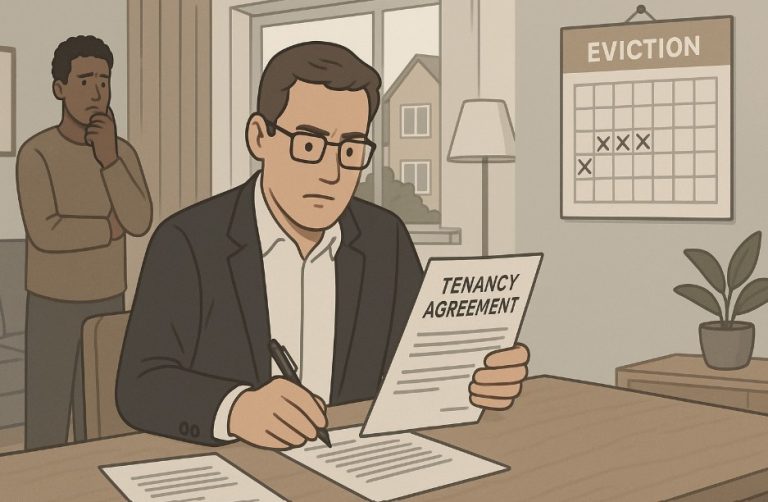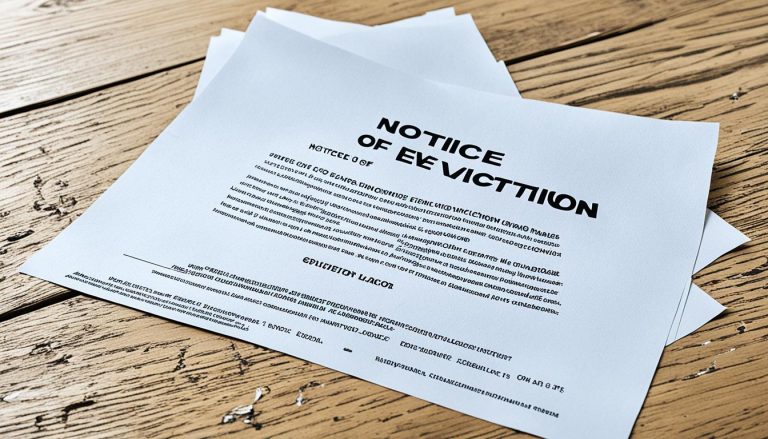Did you know that nearly 20% of renters in the UK are on rolling contract tenancies? This often-overlooked form of agreement, also called a periodic tenancy agreement, plays a pivotal role in today’s housing market. Both tenants and landlords must navigate the intricacies of the rolling contract tenancy notice period to ensure a harmonious and legally sound rental relationship.
The termination of a tenancy agreement under a rolling contract introduces several rights and obligations for all involved parties. Understanding these nuances is crucial for effective lease management. A rolling contract, by definition, lacks a fixed end date, rolling from period to period, be it monthly or weekly.
This guide will cover everything you need to know about rolling contract tenancies, from the essentials of the periodic tenancy agreement to precise notice periods that comply with UK regulations. Stay tuned as we delve into how these agreements function and the unique benefits they offer for both renters and property owners.
Understanding Rolling Contract Tenancies
Rolling contract tenancies, often recognised as periodic tenancy agreements, provide substantial flexibility for both landlords and tenants. Predominantly, these agreements continue on a month-to-month or week-to-week basis, making them quite distinct from fixed-term contracts which have a set duration.
Without a predefined end date, a rolling contract tenancy allows tenants to enjoy greater mobility, adapting to life changes without the burden of long-term commitments. Similarly, landlords benefit from the ability to make adjustments based on fluctuating market conditions or personal circumstances.
| Aspect | Rolling Contract Tenancy | Periodic Tenancy Agreement |
|---|---|---|
| Flexibility | High, continues indefinitely | High, follows a more relaxed structure |
| Rental Contract Notice Requirements | Varied, typically between 1 to 2 months | Standardised, usually consistent |
| End Date | No fixed end date | No fixed end date |
The lack of a set duration is a significant feature of rolling contracts. Tenants usually need to adhere to specified rental contract notice requirements when deciding to move on. These requirements can differ based on the agreement terms, generally ranging between one to two months.
In conclusion, a rolling contract tenancy offers adaptability and convenience, making it a favoured choice for many. Understanding how a periodic tenancy agreement operates can help manage expectations and ensure compliance with rental contract notice requirements.
How Rolling Contracts Differ from Fixed-Term Tenancies?
The landscape of rental contracts can be broadly divided into two categories: rolling contract tenancies and fixed-term tenancies. Understanding the differences between these agreements is crucial for both landlords and tenants, especially when considering notice periods and tenancy duration.

Rolling Contract Overview
A rolling contract tenancy, also known as a periodic tenancy, continues on a monthly or weekly basis after the initial fixed term ends. These agreements do not have a set end date, providing flexibility for both the landlord and the tenant. One key question often asked is, do you have to give notice on a rolling contract? The answer is yes, with a typical notice period being one month for tenants and two months for landlords.
Fixed-Term Tenancy Overview
In contrast, fixed-term tenancies are agreements with a specified duration, such as six months or one year. These contracts offer more stability but require both parties to adhere to the terms until the end date. The need to give notice on a fixed-term tenancy depends on whether the contract is coming to its end or if a break clause is included.
Key Differences Explained
When contrasting rolling contract tenancies and fixed-term tenancies, several distinctions emerge. A fixed-term tenancy provides a clear timeframe, whereas a rolling contract offers indefinite tenure with periodic renewals. Moreover, notice requirements differ significantly: tenants must typically provide one month’s notice in a rolling contract, while fixed-term contracts may not require notice until the end of the term unless a break clause exists.
- Duration: Fixed-term tenancies have a set period, while rolling contracts are indefinite.
- Flexibility: Rolling contracts offer flexibility with monthly or weekly renewals, unlike the rigid structure of fixed-term agreements.
- Notice Period: Rolling contracts usually require one month’s notice by tenants, contrasting with potentially no notice needed for fixed-term leases ending naturally.
In conclusion, both rolling contract tenancies and fixed-term tenancies have their unique characteristics, which affect notice requirements and the longevity of the tenancy. Understanding these distinctions helps in making informed decisions when entering or renewing rental agreements.
Tenancy Agreement Terms: What You Need to Know
Understanding the crucial elements of tenancy agreement terms is essential for both landlords and tenants. These terms serve as a binding legal framework that delineates the rights and responsibilities of each party throughout the tenancy duration.
The agreement should be thoroughly reviewed and comprehended to avoid any potential disputes or misunderstandings. Below, we explore key components that every tenancy agreement should include.
Essential Clauses
Essential clauses within a tenancy agreement form the backbone of the document, ensuring that all basic terms of the rental arrangement are clearly outlined. Important aspects to cover include:
- Rent Amount and Payment Schedule: Specifies the monthly rent amount and the due date for payments.
- Deposit Details: Outlines the security deposit required, its amount, and the conditions under which it will be returned.
- Maintenance Responsibilities: Clarifies who is responsible for maintaining the property and addressing repairs.
- Occupancy Limits: Establishes the maximum number of occupants allowed in the rental property.
Break Clauses
Break clauses in tenancy agreement are pivotal in providing flexibility for both parties. These clauses permit either the tenant or landlord to end the agreement early under specific conditions. Common features of break clauses include:
- Notice Periods: Clearly define the length of notice required to activate the break clause.
- Conditions for Activation: Outline any specific conditions that must be met for the break clause to be valid, such as a minimum tenancy period.
Break clauses play a significant role in allowing for the early termination of the agreement, which can be particularly advantageous when circumstances change unexpectedly. Understanding these provisions, along with other tenancy agreement terms and lease extension options, is crucial for maintaining a harmonious landlord-tenant relationship.
Notice Period Requirements in the UK
Understanding the notice period requirements is essential for both tenants and landlords within the UK. The statutory obligations and the specifics of the rental contract notice requirements play a crucial role in adhering to the necessary legal frameworks.
Legal Requirements
In the UK, the legal notice period for ending a tenancy depends on the type of tenancy agreement in place. For assured shorthold tenancies (ASTs), tenants must typically give one month’s notice if paying rent monthly. Landlords, on the other hand, must provide at least two months’ notice. These rental contract notice requirements are designed to offer a fair balance between the rights of both parties.
Tenancy Agreement Specifics
The specifics of a tenancy agreement can sometimes override statutory requirements. For instance, a tenancy agreement might stipulate longer notice periods than those legally required. It is crucial for both tenants and landlords to thoroughly review their contracts to ensure they comply with the agreed-upon terms. Adhering to the legal notice period tenancy UK guidelines not only fosters a smooth transition but also prevents potential disputes.
| Type of Agreement | Tenant Notice Period | Landlord Notice Period |
|---|---|---|
| Assured Shorthold Tenancy (AST) | 1 month | 2 months |
| Non-AST Tenancy | Variable as per agreement | Variable as per agreement |
Landlord and Tenant Rights
Understanding the reciprocal rights of landlords and tenants is essential for maintaining a fair rental environment. Both parties must be aware of their obligations and protections under the law, particularly in the context of a rolling contract.
Landlord Rights
Landlords have several rights that are crucial for the management of their property. They can collect rent in a timely manner, enforce maintenance responsibilities, and enter the property for inspections with reasonable notice. A commonly asked question is, can my landlord evict me on a rolling contract? Yes, they can, provided they follow the proper legal procedures and give the appropriate notice as stipulated in the rental agreement. Additionally, landlords can seek legal action for damages caused by tenants.
Tenant Rights
Tenants, on the other hand, enjoy robust protections to ensure their living conditions are safe and stable. They are entitled to quiet enjoyment of the property, meaning the landlord cannot disturb their peace unduly. For example, any notice to vacate must comply with local laws, ensuring tenants have adequate time to relocate. Moreover, tenants can challenge unjust evictions through appropriate legal channels.
Overall, the balance of landlord tenant rights ensures that both parties can reasonably exercise their rights without infringing on the other, fostering a respectful and legally compliant rental arrangement.
Rolling Contract Tenancy Notice Period
Understanding the rolling contract tenancy notice period is crucial for both tenants and landlords. When a fixed-term tenancy agreement has ended, it usually transitions into a rolling or periodic tenancy, continuing on a week-by-week or month-by-month basis. During this period, determining how much notice do you give a landlord when out of contract? becomes essential.
For tenants, the standard notice is generally at least one month, coinciding with the periodic nature of the tenancy. However, this can vary, so it’s important to check your tenancy agreement to determine if a specific notice period is outlined. Landlords, on the other hand, are required to provide tenants with a minimum of two months’ notice, usually aligned with rental periods. This helps ensure ample time for tenants to make necessary arrangements if they are to vacate the premises.
Providing accurate notice is pivotal to avoid disputes. Consider the following breakdown of notice periods:
| Scenario | Notice Period |
|---|---|
| Tenant giving notice to landlord | At least one month |
| Landlord giving notice to tenant | At least two months |
Concluding, it’s clear that knowing how much notice do you give a landlord when out of contract? is vital for maintaining a smooth tenancy transition, safeguarding the interests of both parties. Never assume the notice period—always confirm through your tenancy agreement and legal guidelines for accuracy.
Benefits and Drawbacks of Rolling Contracts
Rolling contracts, often referred to as periodic tenancy agreements, come with a variety of benefits and drawbacks for both tenants and landlords. Understanding these can help determine whether this flexible tenancy model suits your specific needs.
Advantages
One of the primary benefits of rolling tenancy contracts is the flexibility they offer. For tenants, this type of agreement allows for easier relocation without being tied to a long-term commitment, thus accommodating lifestyle changes or career moves efficiently. Landlords, on the other hand, benefit from the convenience of quickly re-letting a property if the current tenant decides to move out.
Additionally, rolling contracts often align well with market shifts, enabling landlords to adjust rents in line with current trends. This dynamic approach ensures both parties can respond swiftly to changing circumstances, minimising prolonged vacancies or unsuitable rent levels.
Disadvantages
However, rolling contracts are not without their drawbacks. One significant concern is the uncertainty they introduce; tenants might feel insecure about the potential for sudden rent increases or eviction without long-term stability. Landlords too might face unpredictability, dealing with frequent tenant turnovers which can lead to increased maintenance costs and admin burdens.
Moreover, a periodic tenancy notice period can sometimes be shorter than desired, complicating logistical arrangements for both parties. Tenants needing to find new accommodation at short notice can find the process stressful. For landlords, sudden vacancies might result in gaps without rental income, affecting financial stability.
| Aspect | Tenants’ Perspective | Landlords’ Perspective |
|---|---|---|
| Flexibility | High, can relocate easily | High, can adjust rent and find new tenants quickly |
| Security | Low, risk of increased rent or sudden eviction | Low, frequent turnovers and potential vacancies |
| Periodic Tenancy Notice Period | Varies, but can be short | Varies, but might complicate re-letting |
Steps to Properly Terminate a Tenancy Agreement
Terminating a rolling tenancy agreement involves several critical steps to ensure compliance with legal requirements and safeguard both landlords and tenants. Here are the methodical steps to follow:

- Review the Tenancy Agreement: Before leaving a rolling contract tenancy, scrutinise the original contract for any stipulated notice periods and relevant clauses. Understanding these terms is paramount to a smooth termination process.
- Provide Notice: Notify your landlord in writing about your intention to terminate the tenancy. The notice period is typically one rental period for a month-to-month agreement but confirm exact terms within your contract.
- Conduct Property Inspection: Arrange a final inspection with your landlord. Highlight any repairs needed and ensure the property is in good condition to avoid disputes.
- Settle Financial Obligations: Clear any outstanding rent or utility bills before the move-out date. Discuss the return of the security deposit and any deductions that may apply.
- Return Keys and Documentation: Ensure that all keys and relevant documents are returned to the landlord. This step finalises the leaving of a rolling contract tenancy and fulfills the legal obligations.
- Confirm Termination in Writing: After moving out, seek written confirmation from the landlord that the tenancy has been terminated. This provides clear proof in case of future disputes.
| Step | Details |
|---|---|
| Review the Tenancy Agreement | Understand notice periods and specific clauses related to termination |
| Provide Notice | Notify landlord in writing as per the rental period requirements |
| Conduct Property Inspection | Arrange an inspection to ensure property is in good condition |
| Settle Financial Obligations | Clear any outstanding dues before moving out |
| Return Keys and Documentation | Hand over all keys and related documents to the landlord |
| Confirm Termination in Writing | Ensure landlord provides written confirmation of termination |
Property Rental Regulations in the UK
Understanding property rental regulations in the UK is imperative for maintaining a fair and legal relationship between landlords and tenants. This guidance encompasses essential aspects such as government guidelines, landlord obligations, and tenant rights.
Government Guidelines
The UK government has set comprehensive guidelines to ensure fair practice in property rentals. These guidelines cover a range of issues, including minimum standards of living conditions, proper documentation, and mandatory licensing for certain types of properties. Adhering to these regulations helps protect tenant rights UK and ensures landlords meet their obligations.
Compliance and Penalties
Compliance with property rental regulations UK is non-negotiable for landlords. Failure to comply can lead to significant penalties, including fines and potential legal action. Landlords must be aware of their obligations, such as ensuring property safety through regular inspections and addressing necessary repairs promptly. Conversely, tenant rights UK are reinforced through these regulations, providing them with channels to report issues and seek redress.
| Aspect | Tenant Rights | Landlord Obligations |
|---|---|---|
| Property Maintenance | Tenants have the right to a safe and well-maintained property. | Landlords must conduct regular inspections and repairs. |
| Documentation | Tenants should receive proper tenancy agreements. | Landlords are obliged to provide accurate and comprehensive agreements. |
| Licensing | Tenants should verify the property meets licensing requirements. | Landlords must secure appropriate licenses for rental properties. |
| Complaints and Disputes | Tenants can lodge complaints with relevant authorities. | Landlords must respond to and resolve complaints efficiently. |
In summary, adhering to property rental regulations UK safeguards tenant rights UK and ensures landlords fulfil their obligations UK-wide. Familiarity with these regulations helps both parties navigate rental agreements effectively, fostering a more transparent and lawful rental market.
Handling Disputes and Eviction Procedures
Disputes between landlords and tenants are unfortunately common within the UK rental market. Effectively handling landlord and tenant disputes requires a detailed understanding of eviction procedures UK and the legal avenues for resolving rental disputes.

Eviction procedures UK are particularly stringent, ensuring that tenants have ample protection while also providing landlords with a clear process to follow. When resolving rental disputes, it is critical for both parties to be familiar with these regulations. This not only fosters a fair resolution but also prevents any legal missteps.
Landlords must adhere to specific steps before initiating an eviction. These include serving the appropriate notice, such as a Section 21 or Section 8 notice, depending on the circumstances of the tenancy agreement breach. Section 21 is typically used for no-fault eviction, while Section 8 can be invoked when tenants have violated terms of the tenancy.
Resolving rental disputes often involves the intervention of mediation services or seeking advice from organisations like Citizens Advice. Professional mediation can aid in amicably resolving differences, ensuring that landlord and tenant disputes do not escalate to courtroom battles. This approach saves both time and money, promoting a more harmonious landlord-tenant relationship.
Here is a comparison of common reasons for eviction and the required procedures:
| Reason for Eviction | Notice Type | Notice Period |
|---|---|---|
| Non-payment of Rent | Section 8 | 2 Weeks |
| End of Fixed Term | Section 21 | 2 Months |
| Breach of Tenancy Terms | Section 8 | 2 Weeks to 2 Months |
Extending or Renewing a Tenancy Agreement
When a tenancy agreement nears its termination, tenants and landlords may find themselves considering the available lease extension options or perhaps a tenancy agreement renewal. Understanding the necessary steps can ensure a smooth and mutually beneficial process for both parties.
Reaching an Agreement
The first step in either extending or renewing a tenancy agreement is to open clear lines of dialogue between the tenant and landlord. Discussing the lease extension options early allows both parties to voice their terms and preferences. Often, the landlord will provide a proposal that outlines the new terms, which can then be negotiated to meet mutual consent. Transparency and willingness to reach an agreement are crucial.
Formalising the Extension
Once an agreement is reached, it’s essential to formalise the tenancy agreement renewal in writing. This newly drafted document should include any updated terms, such as changes in rent, duration extension, or any other relevant conditions agreed upon by both parties. A formalised agreement provides legal protection and clarity, ensuring that both tenants and landlords are aware of their renewed commitments and obligations.
Common Mistakes to Avoid
In navigating tenancy agreements, several common tenancy mistakes can lead to complications if not correctly handled. This section highlights such pitfalls and provides guidance on avoiding tenancy complications to ensure a smooth experience for tenants and landlords alike.
Incorrect Notice Periods
One of the frequent errors in tenancy agreements is adhering to incorrect notice periods. Failure to provide or request the correct notice can result in legal complications and potential disputes. It is crucial to understand the notice requirements based on the type of tenancy agreement, whether it is a fixed-term or periodic tenancy.
Lack of Written Agreement
Another prevalent issue is the absence of a written agreement. A written contract helps avoid tenancy complications by clearly laying out the terms agreed upon by both parties. Ensuring all agreements are documented and signed provides a reference point, reducing misunderstandings and ensuring a legal framework is in place.
| Common Mistake | Potential Complication | How to Avoid |
|---|---|---|
| Incorrect Notice Periods | Legal disputes, potential penalties | Ensure familiarity with statutory notice requirements and respective tenancy agreements |
| Lack of Written Agreement | Misunderstandings, lack of legal protection | Always document tenancy agreements in writing and have them signed by all parties |
Conclusion
In navigating the intricate landscape of rolling contract tenancy notice periods in the UK, it is crucial for both landlords and tenants to have a comprehensive understanding of their respective rights and responsibilities. Ensuring proper adherence to legal notice period requirements not only fosters a harmonious relationship but also ensures a fair and equitable termination process.
Landlords bear the responsibility of providing a secure tenancy environment, while tenants must comply with contract terms and offer reasonable notice periods. Upholding these tenant responsibilities and landlord responsibilities helps in maintaining trust and transparency, ultimately benefiting both parties. The fluid nature of rolling contracts, often linked to periodic tenancy agreements, offers flexibility but requires clarity in communication and adherence to statutory obligations.
Securing tenancy rights is paramount in a fair rental ecosystem. By committing to understanding and upholding these rights and duties, landlords and tenants alike can foster a smooth, respectful, and legally compliant tenancy relationship. This guide serves as a vital resource in achieving an informed, balanced, and secure approach to rolling contract tenancies in the UK.
FAQ
Do you have to give notice on a rolling contract?
Yes, notice is required to terminate a rolling contract. The specific notice period is generally outlined in the tenancy agreement, but typically a tenant must give at least one month’s notice if they pay rent monthly, or one week’s notice if they pay weekly.
Can my landlord evict me on a rolling contract?
Yes, landlords can evict tenants on a rolling contract, but they must follow the proper legal procedures, which usually includes giving at least two months’ notice under a Section 21 notice.
How much notice do you give a landlord when out of contract?
If you are on a rolling contract and wish to terminate the tenancy, you typically need to provide one month’s notice if you pay rent monthly. Always check your tenancy agreement for specific requirements.
Can a landlord ask for 2 months’ notice?
It is uncommon for a landlord to require more than the statutory notice period from tenants, but it depends on the specific terms outlined in the tenancy agreement. Generally, landlords must provide tenants with at least two months’ notice to terminate a rolling contract.





